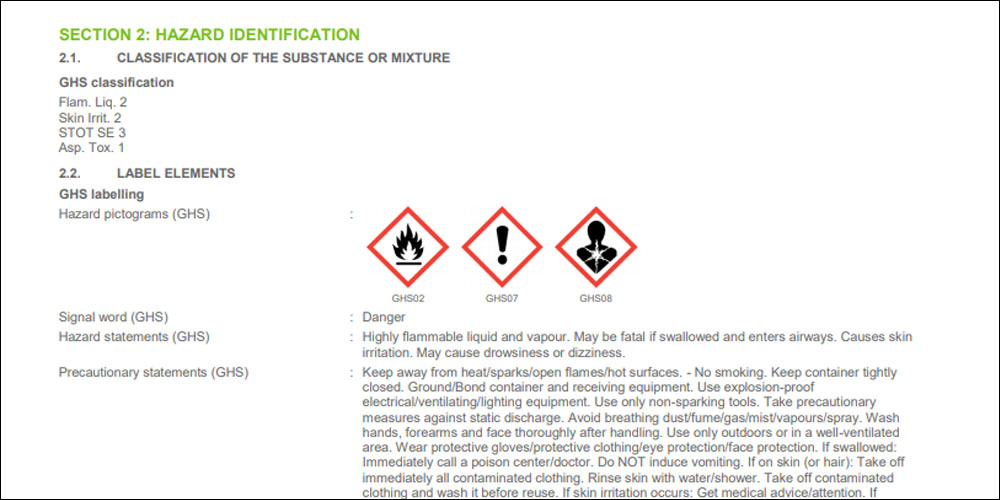The Safety Data Sheet for a product includes important information on the chemical properties, the physical, health and environmental hazards, and safety precautions for handling, storing and transporting the product. The current Safety Data Sheets comply with the US OSHA Hazcom 2012 GHS regulations and have 16 sections of safety and hazard information. The Safety Data Sheets must contain the 16 sections to comply with the UN GHS standards but only sections 1-11 & 16 are mandated by OSHA as sections 12-15 contain matters that are regulated by other agencies. Here we break down 5 major sections and explain why the information is important for product selection.
Section 1: Identification
The first section of a Safety Data Sheet will contain the product’s name, code, usage, manufacturer name and emergency contact information. This information will tell you what the manufacturer suggested usage is and the contact information will be useful for contacting the manufacturer with questions or in in times of an emergency (spills, damages, etc.).
Section 2: Hazard Identification
The second section of a Safety Data Sheet will list any hazards of the product if applicable. It will contain the GHS hazard pictogram(s) along with the hazard and precautionary statements relating to the types of hazards, safe handling, storage and disposal. If a product is not hazardous, this section will not contain any hazard information. Shown below is an example of what section 2 of a product Safety Data Sheet may look like:
Section 2.1 lists the GHS hazards; there are three types of hazards that a material can be classified as: physical, health and environmental. The environmental hazards are not required by OSHA.
The physical hazards are hazards that can cause damage to the body and surrounding areas and materials (i.e. skin corrosion, metal corrosion, flammable liquid) whereas health hazards can cause damage to human health (i.e. respiratory, vision).
Section 2.2 contains the hazard pictograms and statements. The pictograms correspond to different hazards and are used to tell the user quickly what and how severe the hazard is. For example, pictured above is the flammable and exclamation pictograms; the flammable pictogram is used for physical hazards indicating that the material is flammable, and the exclamation pictogram is used for health hazards indicating a hazard to human health.
The hazard statements relay the hazards and degree of the hazard of the material. The precautionary statements describe the measures advised to minimize or prevent adverse effects of the material and proper handling.

Section 8: Exposure Control/Personal Protection
The eighth section of a Safety Data Sheet will contain the exposure limits and suggested controls for the product during use. This information should be checked to see what safe levels the user of the product can be exposed to while using the product and what the suggested exposure controls are from the manufacturer to prevent exposure. The exposure limits on Magnaflux SDSs are listed by individual ingredient. This is done to provide all available data to those using the product. Some products may require little Personal Protective Equipment (PPE) and environmental controls where other more hazardous products will require more stringent PPE and environmental controls to reduce exposure to the user and the environment. It is suggested that when reviewing this section to work with your EHS professional or equivalent to determine the appropriate exposure limits and controls.
Section 9: Physical and Chemical Properties
The ninth section of the Safety Data Sheet contains the physical and chemical properties of the product. The information in this section is very useful in determining if the product is comparable to another or compatible for the parts and process it will be used in.
Section 15: Regulatory Information
The fifteenth section of the Safety Data Sheet contains various regulatory information about the product. This is one of the sections of a Safety Data Sheet that is not mandatory so the information that is listed is up to the manufacturer to provide. This section is useful to check and see if the product is compliant with any regulations applicable to the user’s location.
Magnaflux is completely transparent with their product documentation, therefore safety data sheets are readily available and easy to find. Download relevant Safety Data Sheets and be sure you understand what chemicals you are handling.
Published October 2, 2018